SLVSAW1A June 2011 – January 2017 TPS65053-Q1
PRODUCTION DATA.
- 1 Features
- 2 Applications
- 3 Description
- 4 Revision History
- 5 Pin Configuration and Function
- 6 Specifications
- 7 Detailed Description
- 8 Application and Implementation
- 9 Power Supply Recommendations
- 10Layout
- 11Device and Documentation Support
- 12Mechanical, Packaging, and Orderable Information
パッケージ・オプション
メカニカル・データ(パッケージ|ピン)
- RGE|24
サーマルパッド・メカニカル・データ
- RGE|24
発注情報
8 Application and Implementation
NOTE
Information in the following applications sections is not part of the TI component specification, and TI does not warrant its accuracy or completeness. TI’s customers are responsible for determining suitability of components for their purposes. Customers should validate and test their design implementation to confirm system functionality.
8.1 Application Information
The TPS65053-Q1 PMIC integrates two step-down converters and three LDOs which can be used to power the voltage rails needed by a processor or another application. The PMIC can be controlled via the ENABLE and MODE pins or sequenced from the VIN using RC delay circuits. There is a logic output, RESET, to provide the application processor or load a logic signal indicating power good or reset.
8.2 Typical Application
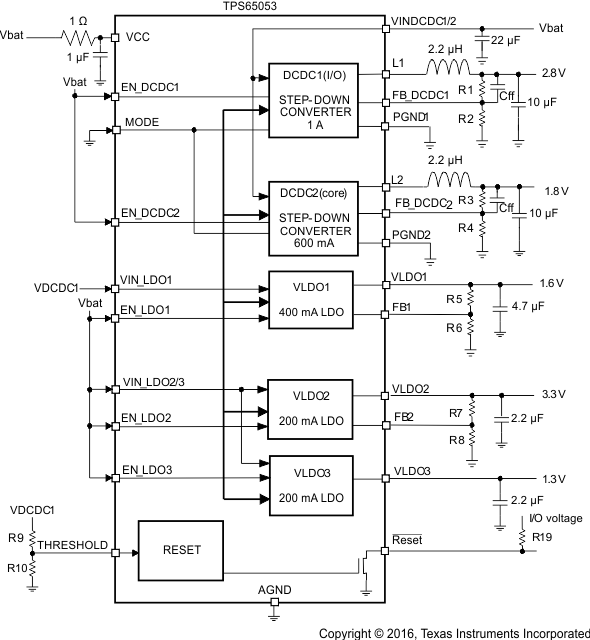 Figure 9. Typical Application Circuit
Figure 9. Typical Application Circuit
8.2.1 Design Requirements
Table 1 lists the design parameters for this application example.
Table 1. Power Design Requirements
| PARAMETER | VALUE |
|---|---|
| Buck 1 and 2 Input voltage, VINDCDC1/2 | 2.9 to 6 V (labeled Vbat in Figure 9) |
| Buck 1 Output voltage, VDCDC1 | 2.85 V (see Table 2 for FB_DCDC1 resistor divider selection) |
| Buck 1 Output current, IOUTDCDC1 | 1 A |
| Buck 2 Output voltage, VDCDC2 | 1.8 V (see Table 2 for FB_DCDC2 resistor divider selection) |
| Buck 2 Output current, IOUTDCDC2 | 600 mA |
| Linear Regulator 1 Input voltage, VINLDO1 | 2.85 V (from VDCDC1, as shown in Figure 9) |
| Linear Regulator 1 Output voltage, VLDO1 | 1.6 V (see Table 5 for FB_LDO1 resistor divider selection) |
| Linear Regulator 1 Output current, ILDO1 | 400 mA |
| Linear Regulator 2 and 3 Input voltage, VINLDO2/3 | 2.9 to 6 V (labeled Vbat in Figure 9) |
| Linear Regulator 2 Output voltage, VLDO2 | 3.3 V (see Table 5 for FB_LDO2 resistor divider selection) |
| Linear Regulator 2 Output current, ILDO2 | 200 mA |
| Linear Regulator 3 Output voltage, VLDO3 | 1.3 V (fixed) |
| Linear Regulator 3 Output current, ILDO3 | 200 mA |
8.2.2 Detailed Design Procedure
8.2.2.1 Output Voltage Setting
Use Equation 4 to calculate the output voltage of the DC-DC converters, with an internal reference voltage Vref, 0.6 V (typical). This voltage can be set by an external resistor network.

TI recommends setting the total resistance of R1 + R2 to less than 1 MΩ. The resistor network connects to the input of the feedback amplifier; therefore, requiring some small feed-forward capacitor in parallel to R1. A typical value of 47 pF is sufficient.

Table 2. Typical DC-DC Feedback Resistor Values
| OUTPUT VOLTAGE | R1 | R2 | NOMINAL VOLTAGE | TYPICAL Cff |
|---|---|---|---|---|
| 3.3 V | 680 kΩ | 150 kΩ | 3.32 V | 47 pF |
| 3 V | 510 kΩ | 130 kΩ | 2.95 V | 47 pF |
| 2.85 V | 560 kΩ | 150 kΩ | 2.84 V | 47 pF |
| 2.5 V | 510 kΩ | 160 kΩ | 2.51 V | 47 pF |
| 1.8 V | 300 kΩ | 150 kΩ | 1.8 V | 47 pF |
| 1.6 V | 200 kΩ | 120 kΩ | 1.6 V | 47 pF |
| 1.5 V | 300 kΩ | 200 kΩ | 1.5 V | 47 pF |
| 1.2 V | 330 kΩ | 330 kΩ | 1.2 V | 47 pF |
8.2.2.2 Output Filter Design (Inductor and Output Capacitor)
8.2.2.2.1 Inductor Selection
The two converters operate typically with a 2.2-μH output inductor. Larger or smaller inductor values can be used to optimize the performance of the device for specific operation conditions. For output voltages higher than 2.8 V, an inductor value of 3.3 μH minimum should be selected, otherwise the inductor current will ramp down too fast causing imprecise internal current measurement and therefore increased output voltage ripple under some operating conditions in PFM mode.
The selected inductor must be rated for its DC resistance and saturation current. The DC resistance of the inductance will influence directly the efficiency of the converter. Therefore an inductor with lowest DC resistance should be selected for highest efficiency.
Use Equation 6 to calculate the maximum inductor current under static load conditions. The saturation current of the inductor should be rated higher than the maximum inductor current as calculated with Equation 6. This is recommended because during heavy load transient the inductor current will rise above the calculated value.

where
- f = Switching Frequency (2.25-MHz typical)
- L = Inductor Value
- Δ IL = Peak-to-peak inductor ripple current
- ILmax = Maximum Inductor current
The highest inductor current occurs at the maximum VIN. Open core inductors have a soft saturation characteristic, and they can normally handle higher inductor currents versus a comparable shielded inductor.
A more conservative approach is to select the inductor current rating just for the maximum switch current of the corresponding converter. The fact that the core material from inductor to inductor differs and will have an impact on the efficiency especially at high switching frequencies must be considered. Refer to Table 3 and the typical applications for possible inductors.
Table 3. Tested Inductors
| INDUCTOR TYPE | INDUCTOR VALUE | SUPPLIER |
|---|---|---|
| LPS3010 | 2.2 μH | Coilcraft |
| LPS3015 | 3.3 μH | Coilcraft |
| LPS4012 | 2.2 μH | Coilcraft |
| VLF4012 | 2.2 μH | TDK |
8.2.2.2.2 Output Capacitor Selection
The advanced Fast Response voltage mode control scheme of the two converters allow the use of small ceramic capacitors with a typical value of 10 μF, without having large output voltage under and overshoots during heavy load transients. Ceramic capacitors having low ESR values result in lowest output voltage ripple and are therefore recommended. See the recommended components in Table 5.
If ceramic output capacitors are used, the capacitor RMS ripple current rating will always meet the application requirements. Use Equation 7 to calculate the rms ripple current.

At nominal load current, the inductive converters operate in PWM mode and the overall output voltage ripple is the sum of the voltage spike caused by the output capacitor ESR plus the voltage ripple caused by charging and discharging the output capacitor as shown in Equation 8.

Where the highest output voltage ripple occurs at the highest input voltage, VIN.
At light load currents, the converters operate in Power Save Mode and the output voltage ripple is dependent on the output capacitor value. The output voltage ripple is set by the internal comparator delay and the external capacitor. The typical output voltage ripple is less than 1% of the nominal output voltage.
8.2.2.2.3 Input Capacitor Selection
Because of the nature of the buck converter, having a pulsating input current, a low ESR input capacitor is required for best input voltage filtering and minimizing the interference with other circuits caused by high input voltage spikes. The converters need a ceramic input capacitor of 10 μF. The input capacitor can be increased without any limit for better input voltage filtering.
Table 4. Possible Capacitors for DC-DC Converters and LDOs
| CAPACITOR VALUE | SIZE | SUPPLIER | TYPE |
|---|---|---|---|
| 2.2 μF | 0805 | TDK C2012X5R0J226MT | Ceramic |
| 2.2 μF | 0805 | Taiyo Yuden JMK212BJ226MG | Ceramic |
| 10 μF | 0805 | Taiyo Yuden JMK212BJ106M | Ceramic |
| 10 μF | 0805 | TDK C2012X5R0J106M | Ceramic |
8.2.2.3 Low Dropout Voltage Regulators (LDOs)
The output voltage of LDO1 and LDO2 can be set by an external resistor network and can be calculated as shown in Equation 9 with an internal reference voltage, Vref, typical 1 V.

TI recommends setting the total resistance of R5 + R6 to less than 1 MΩ. Typically, no feedforward capacitor is required at the voltage dividers for the LDOs.

Table 5. Typical LDO Feedback Resistor Values
| OUTPUT VOLTAGE | R5 | R6 | NOMINAL VOLTAGE |
|---|---|---|---|
| 3.3 V | 300 kΩ | 130 kΩ | 3.31 V |
| 3 V | 300 kΩ | 150 kΩ | 3 V |
| 2.85 V | 240 kΩ | 130 kΩ | 2.85 V |
| 2.8 V | 360 kΩ | 200 kΩ | 2.8 V |
| 2.5 V | 300 kΩ | 200 kΩ | 2.5 V |
| 1.8 V | 240 kΩ | 300 kΩ | 1.8 V |
| 1.5 V | 150 kΩ | 300 kΩ | 1.5 V |
| 1.3 V | 36 kΩ | 120 kΩ | 1.3 V |
| 1.2 V | 100 kΩ | 510 kΩ | 1.19 V |
| 1.1 V | 33 kΩ | 330 kΩ | 1.1 V |
8.2.2.3.1 Input Capacitor and Output Capacitor Selection for the LDOs
The minimum input capacitor on VIN_LDO1 and on VIN_LDO2/3 is 2.2 μF minimum. LDO1 is designed to be stable with an output capacitor of 4.7 μF minimum; whereas, LDO2 and LDO3 are stable with a minimum capacitor value of 2.2 μF.
8.2.3 Application Curves
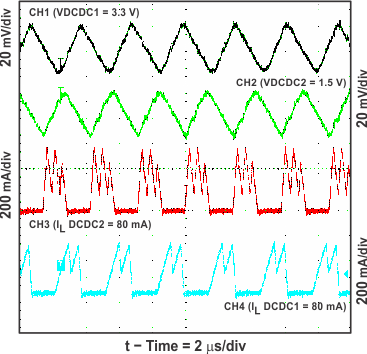
| PWM/PFM Mode = Low |
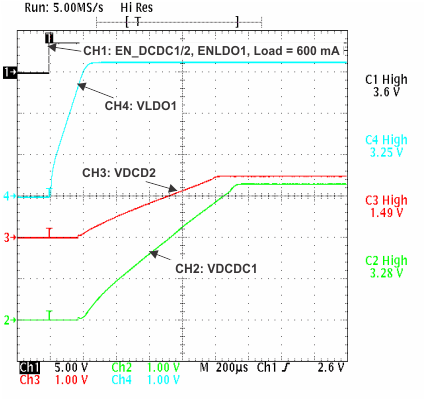 Figure 12. DCDC1, DCDC2, LDO1 Startup Timing
Figure 12. DCDC1, DCDC2, LDO1 Startup Timing
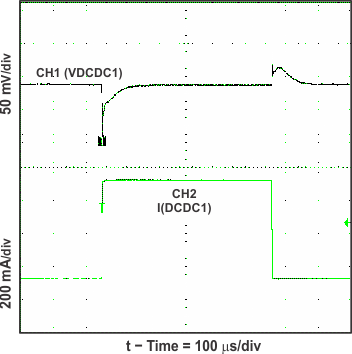 Figure 14. DCDC1 Load Transient Response in PWM Mode
Figure 14. DCDC1 Load Transient Response in PWM Mode
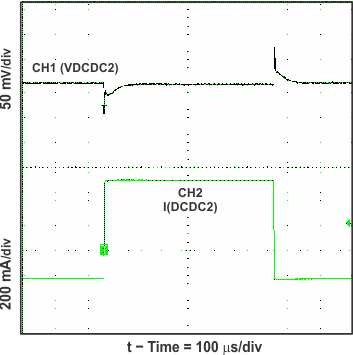 Figure 16. DCDC2 Load Transient Response in PWM Mode
Figure 16. DCDC2 Load Transient Response in PWM Mode
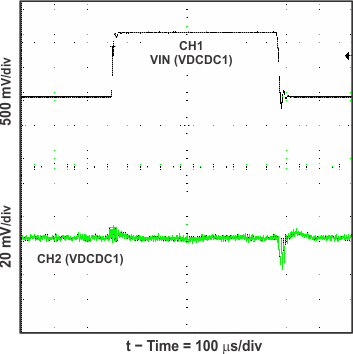 Figure 18. DCDC1 Line Transient Response in PWM Mode
Figure 18. DCDC1 Line Transient Response in PWM Mode
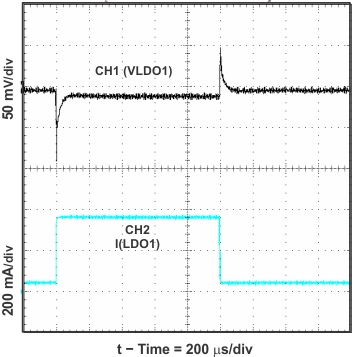 Figure 20. LDO1 Load Transient Response
Figure 20. LDO1 Load Transient Response
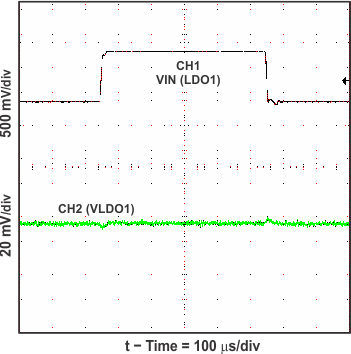 Figure 22. LDO1 Line Transient Response
Figure 22. LDO1 Line Transient Response
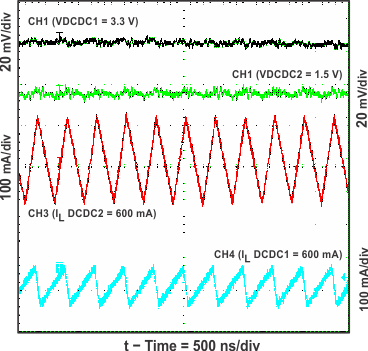
| PWM Mode = High |
PWM Mode
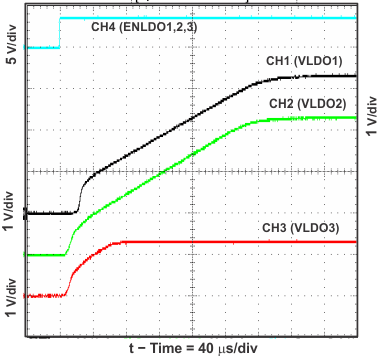 Figure 13. LDO1 to LDO3 Startup Timing
Figure 13. LDO1 to LDO3 Startup Timing
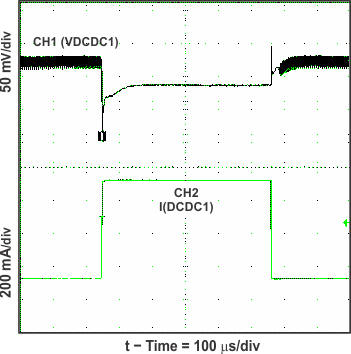 Figure 15. DCDC1 Load Transient Response in PFM Mode
Figure 15. DCDC1 Load Transient Response in PFM Mode
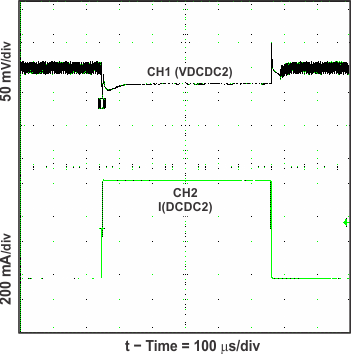 Figure 17. DCDC2 Load Transient Response in PFM Mode
Figure 17. DCDC2 Load Transient Response in PFM Mode
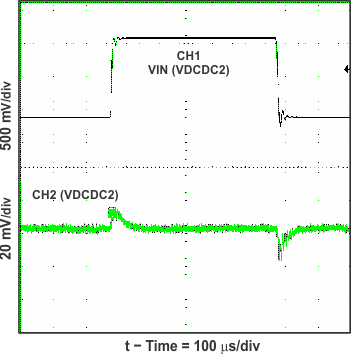 Figure 19. DCDC2 Line Transient Response in PWM Mode
Figure 19. DCDC2 Line Transient Response in PWM Mode
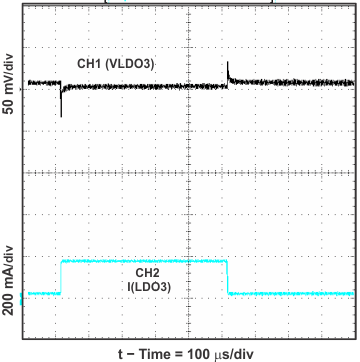 Figure 21. LDO3 Load Transient Response
Figure 21. LDO3 Load Transient Response